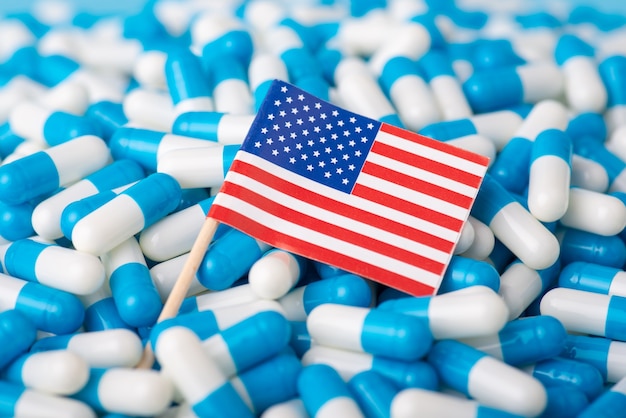Federal Efforts to Reduce Drug Costs: Latest Developments in Policy

Federal efforts to reduce prescription drug costs involve legislative measures, executive actions, and regulatory changes aimed at lowering drug prices, increasing affordability, and improving access to medications for Americans.
Navigating the complex landscape of healthcare costs can be daunting, especially when it comes to prescription medications. The issue of high drug prices has gained significant attention, prompting various federal initiatives aimed at providing relief. Stay informed on federal efforts to reduce prescription drug costs: What are the Latest Developments?
Understanding the Landscape of Prescription Drug Costs
Prescription drug costs in the United States have been a long-standing concern, affecting millions of Americans. Several factors contribute to these high costs, including market exclusivity, patent protection, and the complexities of the pharmaceutical supply chain. Understanding these elements is crucial to grasp the scope and impact of federal efforts to address the issue.
Factors Contributing to High Drug Costs
Several elements influence the prices Americans pay for their prescription drugs. These include:
- Patent Protection: Pharmaceutical companies often obtain patents that grant them exclusive rights to manufacture and sell a drug for a certain period, typically around 20 years. This monopoly allows them to set prices without competition.
- Market Exclusivity: In addition to patents, regulatory exclusivities, such as those granted by the FDA for orphan drugs or new chemical entities, can further extend market protection, impacting pricing decisions.
- Lack of Negotiation: Unlike many other developed countries, the U.S. government doesn’t directly negotiate drug prices with manufacturers for Medicare beneficiaries, leading to higher costs.
The absence of standardized pricing regulations and the intricate involvement of pharmacy benefit managers (PBMs) in negotiating rebates and discounts further complicate the drug pricing landscape.

The high cost of prescription drugs has several impacts, including reduced access to medications, increased healthcare disparities, and financial strain on individuals and families. Federal intervention is essential to mitigate these effects and ensure patients can afford the treatments they need.
Legislative Actions to Lower Drug Prices
Congress has been actively involved in crafting legislation to address the high costs of prescription drugs. The Inflation Reduction Act of 2022 marked a significant step forward, introducing several key provisions aimed at reducing drug prices for Medicare beneficiaries.
Key Provisions of the Inflation Reduction Act
The Inflation Reduction Act includes several provisions designed to lower drug costs, such as:
- Medicare Negotiation: For the first time, Medicare can negotiate prices for certain high-cost drugs, starting with a select number of medications. This provision could lead to significant savings for the program and its beneficiaries.
- Inflation Rebates: Drug manufacturers are required to pay rebates to Medicare if they increase prices faster than inflation. This measure aims to discourage excessive price hikes.
- Part D Reforms: The act includes changes to the Medicare Part D program, such as a cap on out-of-pocket costs for beneficiaries and enhanced subsidies for low-income individuals. These reforms are expected to improve affordability and access to medications.
These legislative actions represent a major shift in federal policy, moving toward greater government intervention in drug pricing. The long-term effects of these changes will be closely monitored to assess their impact on affordability and innovation in the pharmaceutical industry.
In addition to the Inflation Reduction Act, other proposed legislation aims to address different aspects of drug pricing. These include bills focused on transparency, competition, and biosimilar development, reflecting a multifaceted approach to tackling the issue.
Executive Orders and Regulatory Changes
In addition to legislative actions, the executive branch has also taken steps to reduce prescription drug costs through executive orders and regulatory changes. These measures often target specific aspects of the pharmaceutical industry, such as drug importation and rebates.

Targeting Drug Importation and Rebates
Executive actions have focused on:
- Drug Importation: Some executive orders have explored the possibility of importing drugs from Canada and other countries where prices are lower. The goal is to increase competition and provide Americans with access to more affordable medications.
- Rebate Reform: Changes to the rebate system, involving pharmacy benefit managers (PBMs), have been proposed to ensure that discounts and savings are passed on to consumers rather than being retained by intermediaries.
- Transparency Initiatives: Efforts to increase transparency in drug pricing are also underway, with the aim of shedding light on the complex factors that influence costs and empowering consumers to make informed decisions.
The implementation of these executive actions and regulatory changes faces various challenges, including legal hurdles and industry resistance. However, they represent a significant effort to use the authority of the executive branch to address the issue of high drug prices.
The effectiveness of these measures will depend on their implementation and enforcement, as well as the response from pharmaceutical companies and other stakeholders in the healthcare system.
The Role of Pharmacy Benefit Managers (PBMs)
Pharmacy Benefit Managers (PBMs) play a crucial role in the prescription drug supply chain, acting as intermediaries between drug manufacturers, pharmacies, and health plans. Their influence on drug pricing has come under scrutiny, with concerns raised about transparency and potential conflicts of interest.
Concerns About Transparency and Conflicts of Interest
PBMs negotiate rebates and discounts with drug manufacturers. However, questions have been raised about:
- Rebate Transparency: The lack of transparency in how rebates are negotiated and distributed has led to calls for greater accountability. Critics argue that PBMs may not always pass on the full savings to consumers.
- Conflicts of Interest: Some PBMs are affiliated with or owned by insurance companies, raising concerns about whether they prioritize the interests of their parent companies over those of patients and payers.
- Formulary Management: PBMs develop formularies that determine which drugs are covered by health plans. The criteria used to make these formulary decisions can have a significant impact on drug costs and access.
Efforts to reform PBM practices are underway, with proposals to increase transparency, eliminate conflicts of interest, and ensure that savings are passed on to consumers. These reforms could have a significant impact on the drug pricing landscape.
The debate over the role of PBMs highlights the complexities of the pharmaceutical supply chain and the need for comprehensive solutions to address high drug prices.
Impact on Patients and Healthcare Providers
The high cost of prescription drugs has a direct impact on patients and healthcare providers, affecting access to care, treatment decisions, and overall health outcomes. Federal efforts to reduce drug prices aim to alleviate these burdens and improve the healthcare system.
Improving Access to Care and Treatment Decisions
Lower drug prices can lead to:
- Increased Adherence: When medications are more affordable, patients are more likely to adhere to their prescribed treatment plans, leading to better health outcomes.
- Reduced Disparities: Lower costs can help reduce healthcare disparities by improving access to medications for low-income individuals and underserved communities.
- Informed Decisions: When costs are less of a barrier, healthcare providers can make treatment decisions based on the best clinical evidence rather than financial considerations.
However, it is important to consider the potential impact on pharmaceutical innovation. Drug companies argue that high prices are necessary to fund research and development of new medications. Finding a balance between affordability and innovation is crucial to ensure that patients have access to both existing treatments and future breakthroughs.
The outcomes of federal efforts to reduce drug prices will be closely watched to assess their impact on patients, healthcare providers, and the pharmaceutical industry.
Future Trends and Challenges
The quest to lower prescription drug costs is an ongoing process, with future trends and challenges on the horizon. Technological advancements, evolving market dynamics, and policy debates will continue to shape the landscape of drug pricing in the United States.
Navigating Technological Advancements and Policy Debates
Considerations for the future include:
- Biosimilars: Increased use of biosimilars, which are similar to brand-name biologic drugs, could help lower costs through competition. However, regulatory and market barriers to biosimilar adoption need to be addressed.
- Value-Based Pricing: Exploring value-based pricing models, where drug prices are tied to their clinical effectiveness, could align incentives and ensure that patients get the most value for their healthcare dollars.
- International Collaboration: Collaborating with other countries to negotiate drug prices or share research and development costs could help reduce the burden on the U.S. healthcare system.
Addressing the high cost of prescription drugs requires a comprehensive and collaborative approach, involving policymakers, healthcare providers, pharmaceutical companies, and patients. By working together, it is possible to create a more affordable and accessible healthcare system for all Americans.
The ongoing policy debates and technological advancements will continue to shape the future of drug pricing in the United States. Staying informed about these developments is essential for understanding the forces that will influence access to medications and healthcare affordability.
| Key Point | Brief Description |
|---|---|
| 💊 Inflation Reduction Act | Allows Medicare to negotiate drug prices and caps out-of-pocket costs. |
| ⚖️ Executive Orders | Focus on drug importation and rebate reforms to lower consumer costs. |
| 💰 PBM Role | Concerns raised about transparency and conflicts of interest in drug pricing. |
| 📈 Future Trends | Biosimilars and value-based pricing could further reduce costs. |
Frequently Asked Questions
▼
The Inflation Reduction Act is a law that allows Medicare to negotiate drug prices, caps out-of-pocket drug costs for Medicare beneficiaries, and requires drug companies to pay rebates if they increase prices faster than inflation.
▼
Executive orders aim to lower drug costs by targeting drug importation from countries with lower prices and reforming rebate systems to ensure savings are passed on to consumers rather than retained by intermediaries.
▼
PBMs negotiate drug prices with manufacturers, creating formularies and managing drug benefits for health plans. However, concerns exist regarding their transparency and potential conflicts of interest that may affect drug costs.
▼
Biosimilars are medications that are very similar to brand-name biologic drugs. They can lower healthcare costs by increasing competition in the market, providing more affordable treatment options for patients.
▼
Patients can save money on prescriptions by using generic or biosimilar drugs, comparing prices at different pharmacies, using discount cards or coupons, and discussing cost-saving options with their healthcare providers.
Conclusion
In conclusion, addressing rising prescription drug costs requires a multifaceted approach involving legislative actions like the Inflation Reduction Act, executive orders targeting importation and rebates, and reforms to the role of PBMs. These efforts aim to balance affordability, innovation, and access to ensure patients can receive the treatments they need without financial strain.
